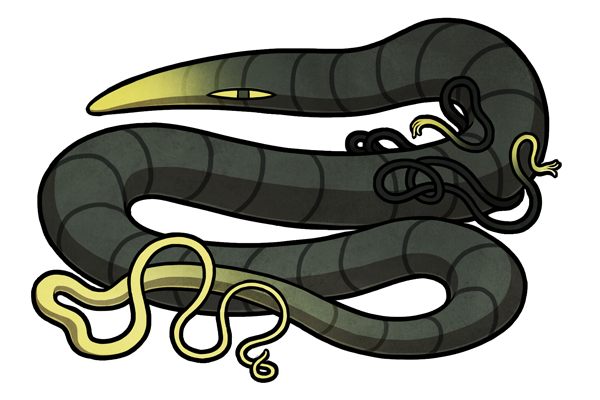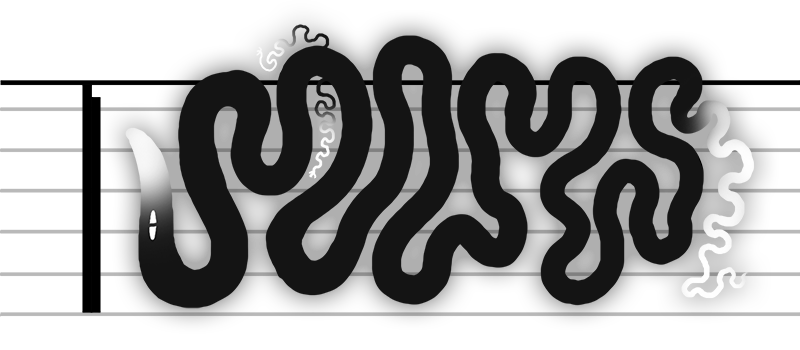

vessobrine
the lanterns
prefix vesso suffix brine
vesperemane lux
physical appearance
The vessobrine /ˈvɛssobriːn/ is a black, thin-striped stranger with a pair of long, cord-like arms. Its coloration is either blue or yellow, with its eye markings reflective even in low light levels. The vessobrine's solid black inner flesh has few characteristics that distinguish it from its exterior skin, aside from a glittering shimmer in the light. This substance is interspersed with veins which grow thicker or more tapered, and are just as likely to link to one another as they are to exist in isolation. The arrangement of these veins is always unique between individuals, and shift somewhat over the course of the vessobrine's life. These changes, however small, are always divergent, tending away from collective uniformity.
Any cut causes the vessobrine to exude a black fog, its flesh dissipating until it disappears completely. It cannot heal from any wound.
the sound of trucks passing by overhead.

environment and generation
The vessobrine can be found beneath bridges or bridge-like structures (such as raised platforms). It prefers to be around quiet and secluded parks at the edges of town, buildings of under three stories in height, and trees and bushes. The vessobrine appears in spaces of near-total darkness, where it bubbles into existence with a low, swelling whoop, its generation taking no more than twenty seconds and leaving behind a gathering of unidentifiable grit on the ground beneath it. The vessobrine exudes a thin, dark mist from its surface for the first several hours of its life, during which it does not move beyond a fidgeting of its arms or a turning of its head several degrees.
behaviour
Once active, the placid vessobrine selects a small, covered space within its environment, and consequently spends the remainder of its lifespan in this space,𐊯 emerging only during the darkest hour of the night. Although the vessobrine appears to rest upon the ground, closer examination reveals that the vessobrine actually levitates about a half-inch above any surface. It is even able to move readily across still water in this fashion, causing no rippling or other disturbance of the waterbody beneath.
𐊯 It folds its coils upon itself, like a spring or a fistful of rope.
During its exploratory forays, it seems to use its arms to touch nearby objects with fleeting, darting touches, although, as with its locomotion, no actual physical contact occurs.
When a vessobrine meets another of its kind, it engages in an arm-flailing display, with occasional additional flicking of the tail-tip in an erratic, non-rhythmic matter. This function and significance of these motions seems variable; sometimes the less energetic of the two vessobrine drives out the other, whereas other times the flapping and waving persists for quite some time, until both individuals leave the area. Though seemingly spasmodic, the vessobrine never hits any object around them no matter how frantic its thrashing becomes.
Encounters with animals tend to incur a similar kind of flapping, with the vessobrine seeming to have little tolerance for companionship within its territory.
interactions with sensitives
The vessobrine regards any sensitive with the same inert curiosity it displays towards its environment, its arms darting around the sensitive, but not touching them. Physical contact must be initiated by the sensitive, either deliberately or via abrupt motion which interrupts the vessobrine's flails. When touched, the vessobrine exhibits a slight increase in its rate of motion, as well as a turning or rotating of the head, and a raising of one or both arms. Yellow vessobrine tend to be both more daring and more fickle, taking both a greater initial interest in any wandering sensitive, but also abandoning this interest at a faster rate.
Physical contact with the vessobrine causes the illusion of daylight. The sun fades into view, and the sky takes on the appearance it had exactly twelve hours prior, including clouds. Blue-eyed vessobrine affect only the appearance of the sky itself (with all objects remaining un-illuminated), while yellow-eyed vessobrine cause the illusion of light cast by the sun, as well. This illusion fades almost immediately after contact ceases.
aging and death
At the end of its life, the vessobrine curls into itself and fades from view. It takes only a second or two, its late presence only marked by several-degree decrease in temperature for a half-minute following its death.



